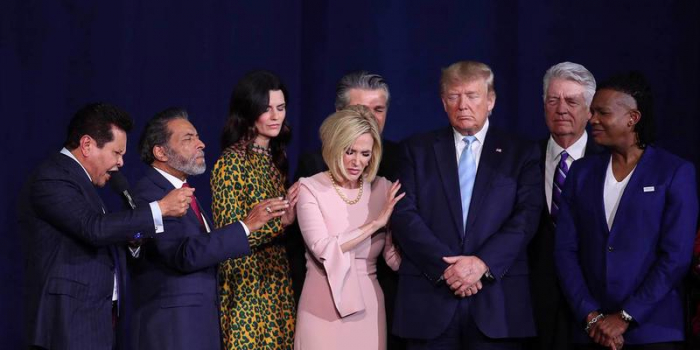US President Donald Trump says he ordered the drone strike that killed General Qassem Suleimani, Iran's second most powerful leader, to “stop a war.” It is far more likely that he has stumbled, one flawed assumption at a time, into starting one.
Before US President Donald Trump decided to withdraw his country from the Joint Comprehensive Plan of Action (JCPOA) in May 2018, Javad Zarif, Iran’s foreign minister and the nuclear agreement’s chief Iranian architect, was the most popular public figure in his country. A year after the withdrawal, a University of Maryland poll shows, Zarif’s popularity was far surpassed by that of General Qassem Suleimani, the hardline Revolutionary Guard commander who was just assassinated in Baghdad on Trump’s order.
Trump says he authorized the drone strike that killed Suleimani to “stop a war.” It is far more likely that he has started one – or at least the march toward one.
No leader can be expected to anticipate precisely the effects of their foreign-policy decisions. But their expectations should be realistic, which means that they should be based on credible intelligence and a comprehensive understanding of the economic, political, historical, and cultural dynamics at work. When expectations are not realistic, the results are often disastrous.
This was the case with US President George W. Bush’s 2003 invasion of Iraq, which, among other things, resulted in hundreds of thousands of Iraqi civilian deaths. And it has been so with virtually all of Trump’s foreign-policy decisions, particularly with regard to Iran.
Trump’s first major mistake was withdrawing from the JCPOA. Iran had not violated the terms of the 2015 nuclear deal, and the other signatories remained committed to it as well. But Trump wanted more concessions from Iran’s leaders, so he disregarded his country’s commitments, re-imposed sanctions, and pushed US partners and allies to follow his lead.
A “maximum pressure” campaign was supposed to lead either to Iran’s quick capitulation to exorbitant US demands, as spelled out by Secretary of State Mike Pompeo, or to economic collapse. In the latter case, Trump’s hawkish advisers assured him, the restless and poverty-stricken Iranian public would reject hardliners like Suleimani and support the rise of a new leadership cadre that would bring peace and stability to the region. In 2018, John Bolton, then Trump’s national security adviser (who had previously advocated bombing Iran into submission), told a group of Iranian exiles that they would be celebrating regime change “before 2019.”
So confident was the Trump administration in its assessment that it seems never to have considered an alternative outcome. For example, it did not account for the possibility that Iran would respond to plummeting oil exports by increasing production. True, this is not the most obvious response, because it could dilute Iran’s remaining export revenues. But Iranians need oil, too, and could not afford the skyrocketing prices of comparable imports; in November, protests against rising gas prices swept the country.
The Trump administration surely did not anticipate that two years after the resumption of sanctions, Iran’s economy would be showing signs of recovery. And yet, during the third quarter of 2019, employment rose by 3.3% year on year, and unemployment declined to a seven-year low.
Clearly, the Trump administration badly misjudged Iran. But false beliefs about the country’s circumstances extend far beyond the White House. A 2018 New York Times op-ed exemplifies the low standard of evidence for reports depicting Iran’s economic and political fragility.
The commentary claimed that, according to “official sources,” 40% of Iranians lived below the poverty line in 2015. But the source to which that claim was hyperlinked led to an obscure Persian-language website that made no mention of any official report. Meanwhile, World Bank data show that the internationally comparable poverty rate in Iran for 2015 was 11%, around the same as in neighboring Turkey.
To be sure, when that article was published, Iranians were protesting economic hardship. But protest does not equal revolution, let alone successful regime change, especially in a country with security forces willing and able to use extreme brutality to crush dissent, as they did to halt November’s gas-price protests.
Yet observers should beware of the assumption that Iran’s hardliners are holding onto power by sheer force. The University of Maryland poll showed widespread support not only for Suleimani, but also for another hardliner: Ebrahim Raisi, who heads Iran’s judiciary.
This is not difficult to understand. In the 2013 and 2017 elections, Iranians threw their support behind the moderate Zarif and President Hassan Rouhani, because they believed that a nuclear agreement would usher in a new era of peace and economic security. But even though those leaders managed to deliver the JCPOA, they were powerless to stop the US from reneging on it.
Iranians wanted stability and prosperity. Instead, they got more economic hardship and unpredictability, including US calls for regime change. Given how poorly US-sponsored regime change has gone for other countries in their neighborhood, many embraced Suleimani, who had successfully defended Iran’s borders against Saddam Hussein in the 1980s, and, more recently, against the Islamic State.
George Orwell famously warned that a false belief ultimately “bumps up against solid reality, usually on a battlefield.” Unfortunately, that seems increasingly likely to happen to the US in Iran – and soon.
Djavad Salehi-Isfahani is Professor of Economics at Virginia Tech, Senior Fellow for Global Economy and Development at the Brookings Institution, and a research fellow at the Economic Research Forum (ERF) in Cairo.
Read the original article on project-syndicate.org.
More about: Trump
















































